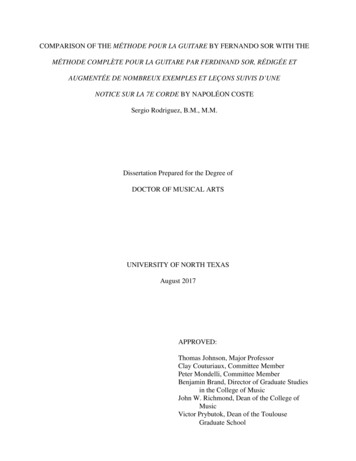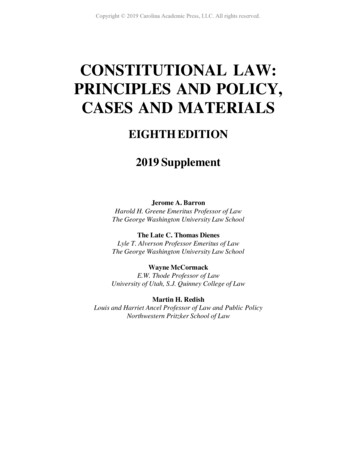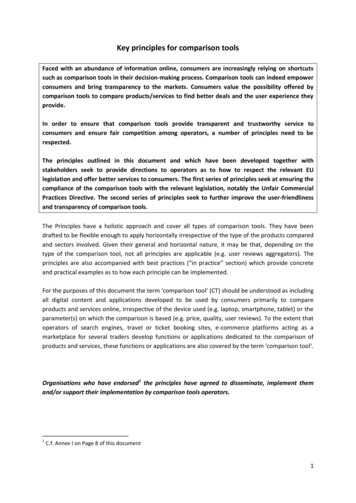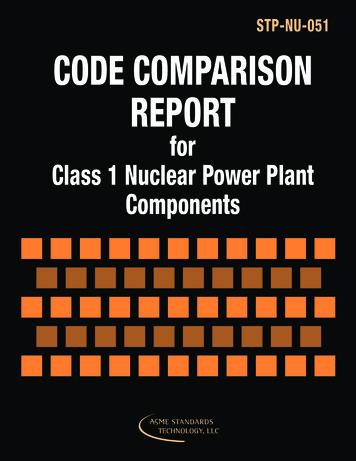
Transcription
COMPARISON OF THE MÉTHODE POUR LA GUITARE BY FERNANDO SOR WITH THEMÉTHODE COMPLÈTE POUR LA GUITARE PAR FERDINAND SOR, RÉDIGÉE ETAUGMENTÉE DE NOMBREUX EXEMPLES ET LEÇONS SUIVIS D’UNENOTICE SUR LA 7E CORDE BY NAPOLÉON COSTESergio Rodriguez, B.M., M.M.Dissertation Prepared for the Degree ofDOCTOR OF MUSICAL ARTSUNIVERSITY OF NORTH TEXASAugust 2017APPROVED:Thomas Johnson, Major ProfessorClay Couturiaux, Committee MemberPeter Mondelli, Committee MemberBenjamin Brand, Director of Graduate Studiesin the College of MusicJohn W. Richmond, Dean of the College ofMusicVictor Prybutok, Dean of the ToulouseGraduate School
Rodriguez, Sergio. Comparison of the "Méthode Pour La Guitare" by Fernando Sor withthe "Méthode Complète Pour La Guitare Par Ferdinand Sor, Rédigée Et Augmentée DeNombreux Exemples Et Leçons Suivis D’une Notice Sur La 7e Corde" by Napoléon Coste.Doctor of Musical Arts (Performance), August 2017, 167 pp., 2 tables, 7 figures, 7 musicalexamples, bibliography, 26 titles.The nineteenth century presents a great increase in publications of guitar methods. Mostauthors of the time published several versions of their works. Fernando Sor, perhaps the mostprominent guitar composers of the time—whose Méthode is regarded today as the mostimportant of the period—only published one edition. However, Napoleon Coste took on the taskto do a second account. The literature reviewed shows substantial existing information regardingbackground, type of text, tone, and contents of Sor’s work, but comparisons to date are notsubstantial. Therefore, there is a need to compare these two texts side by side to yield a completeview of their pairing. The existing negative views of Coste’s edition hinder the importance ofCoste’s work as reference to Segovia’s publication of Sor studies, and as a clearer pedagogicalapplication of many of Sor’s concepts which are sidetracked by his response to criticism and hiselaborations in matters beyond his main subject matter. I provide a comprehensive review ofSor’s method, an outline and a consideration of his concepts. Then I offer a complete Englishtranslation of Coste’s method which is inexistent until now. The comparison follows pointing atdifferences and similarities. Results show that Coste clarifies and complements many of theprinciples in less text and simpler language. He modifies certain others either to approach Sor’spractice or to depart to a newer standard. He offers his own lessons and sections to apply Sor’sconcepts. Coste’s text heads towards a pedagogical synthesis of Sor’s method, but it is
incomplete because he omits some concepts without leading the readers to consult Sor. Coste’spedagogical and practical relevance is fundamental for modern standard techniques.
Copyright 2017bySergio Rodriguezii
ACKNOWLEDGEMENTSI would like to thank my committee members, especially my major professor, ThomasJohnson, for their support and the opportunity they offered to bring this work to completion, aswell as for the experience I received during these graduate years of study. I would like to thankDr. Donna Emmanuel for her part as a committee member at the onset of my work, and I want toextend special thanks to Dr. Peter Mondelli for accepting to become part of my committee at alate stage of the work, and for offering invaluable input.I also want to thank Romaine Duplenne for his generosity in making his work available.I want to extend a special thanks to John Miller and Robert Bixler; two generousindividuals whose trust, enormous parental love and support gave me the great opportunity toinitiate graduate studies and offered encouragement through all these years.I want to thank the staff at the university as well as the many people involved in manyways for graduate students to finish.Finally, I want to give the biggest thanks to my family. I thank my wife, Lauren, for herundiminished support and encouragement through these years of study—all the hard times werefinally worth a dissertation. I thank my mother, Rosalba, for supporting us through this academicprocess while we brought two children to life. I thank my two-year-old son, Matías, for comingto life and for giving up some of his time with Papa while he completed his work. Finally, I wantto thank my newborn son, Jonathan, for his timing in coming to life, which became the final pushto make graduation possible.iii
TABLE OF CONTENTSPageACKNOWLEDGEMENTS . iiiLIST OF TABLES AND FIGURES. viiCHAPTER 1. INTRODUCTION . 1CHAPTER 2. PURPOSE . 4CHAPTER 3. STATE OF THE RESEARCH . 6Origins and Background . 6Type of Text . 8Style and Tone . 10Contents . 12Comparison . 15CHAPTER 4. METHOD . 17CHAPTER 5. REVIEW . 19Comparison of Each Author’s Goals . 19Overview of Subject Headings . 20Comprehensive Review of Sor’s Method . 21Introduction . 21The Instrument . 24Position of the Instrument . 24The Right Hand . 30The Left Hand . 31Way of Plucking the String . 34Quality of Sound . 35Knowledge of the Fingerboard . 40Fingering along the Length of the String . 43Use of the Fingers of the Right Hand . 43Fingering of the Two Hands . 44The Elbow . 45iv
On Thirds, Their Nature and Their Fingering . 47On Sixths. 49Application of the Thirds and the Sixths. 51Fingering of the Left Hand in Regard to the Melody . 52Fingering of the Right Hand . 55Harmonic Sounds . 58Accompaniments. 61Analysis of the Accompaniment of a Fragment of the Oratorio by Haydn (TheCreation) . 64On Fingering of the Annular . 66Conclusion . 67Outline of Sor’s Concepts . 70Translation of Coste’s Method. 80Introduction . 80Part 1: Position of the Instrument . 82Part 2: About the Quality of Sound and the Imitation of Some Instruments. . 90Part 3: About the Thirds and Their Fingering . 97Part 4: Scale in All the Notes . 101Appendix by N. Coste . 106CHAPTER 6. COMPARISON . 110Conceptual Differences . 110Introduction . 111The Left Hand . 113The Right Hand . 118Way of Attacking the String . 122On Tuning of the Guitar . 12231 Lessons and Exercises by N. Coste. 123The Quality of Sound and the Imitation of Some Instruments . 127Knowledge of the Fingerboard . 129Fingering Over the Length of the String . 129Usage of the Fingers of the Right Hand. 130Rule of the Manner of Pressing Chords . 131v
Consideration about the Scales and Their Fingerings. 131The Elbow . 132Scales . 133About the Thirds and Their Fingering . 134On Sixths. 135CHAPTER 7. OPINION . 138Considerations of Sor’s Concepts . 138Position of the Instrument . 138The Right Hand . 139The Left Hand . 140The Way of Plucking the String. 143Quality of Sound . 144Imitation of the Horn . 145Imitation of the Trumpet . 145Knowledge of the Fingerboard . 146The Elbow . 148On Thirds, Their Nature and Their Fingering. 149On Sixths. 150Application of the Thirds and the Sixths . 153Fingering of the Left Hand in Regard to the Melody . 153Harmonics . 157Accompaniments. 160Conclusion . 161CHAPTER 8. CONCLUSION. 162Negative Differences . 164Positive Additions . 165Positive Omissions . 165Different Approaches . 165Final Points . 165BIBLIOGRAPHY . 166vi
LIST OF TABLES AND FIGURESPageTablesTable 1: Subject headings within Sor and Coste’s methods [emphasis added to show differencesbetween the two versions]. 20Table 2: Sor Méthode, Formula of Thirds. . 48FiguresFigure 1: Fernando Sor, Méthode, Figure 7. . 26Figure 2: Sor, Méthode, Figure 9. . 29Figure 3: Sor, Méthode , Figure 11. . 31Figure 4: Sor, Méthode, Figure 12. . 32Figure 5: Sor, Méthode, Figure 14. . 33Figure 6: Sor, Méthode, Figure 18. . 35Figure 7: Sor, Méthode, Figure 22. . 42Musical ExamplesExample 1: Sor, Divertissement Militaire, Op. 49, third movement. . 38Example 2: Nápoleon Coste, Méthode Augmentée, 31 Lessons and Exercises, No. 1. . 124Example 3: Sor, Méthode, Example 18. . 124Example 4: Coste, Méthode Augmentée, 31 Lessons and Exercises, No. 4. 125Example 5: Coste, Méthode Augmentée, 31 Lessons and Exercises, No. 17. . 126Example 6: Sor, Méthode, Example 19. . 133Example 7: Coste, Méthode Augmentée, 31 Lessons and Exercises, No. 6. . 134vii
CHAPTER 1INTRODUCTIONMethods for plucked string instruments have been available ever since the instrumentsthemselves have been studied and played. These historical documents provide insight into thecultural trends and performance practices of the time. Pedagogical texts for the guitar are amongthe most published in history. This was most evident at the turn of the nineteenth century whenthe publications of guitar methods increased dramatically. The spike in production was fueled bythe ongoing change in the format of scores for guitar—from tablature to standard notation—which started in the middle of the eighteenth century,1 as well as with the increased popularity ofthe instrument in the bourgeoisie, particularly in France. Most authors of the time, seeking newopportunities to publish as well as to revise their thoughts, published several editions of the samewritings, resulting simultaneously in increased profits and advanced reputations.Fernando Sor, the leading Spanish guitarist in the nineteenth century Parisian scene andthe most prominent guitar composer of the time, wrote a Méthode which is regarded today as themost important of the period.2 However, he only published one edition. Sor’s important premiseswere sidetracked by his intentions to both distinguish himself from all other guitarists and toraise questions about his contemporaries and their ways of playing the guitar. Throughout hisMéthode, he exchanged criticism with his contemporaries—both critiquing their practices andresponding to their critiques. In order for Sor to have provided a better understanding of hisconcepts, a second, more objective edition would have been necessary, but he never attempted it.Napoleon Coste, another reputed guitar composer of the nineteenth century, moved toParis in 1830 and became a student, friend, and colleague of Fernando Sor. Although Coste12Erik Stenstadvold, An Annotated Bibliography of Guitar Methods (Hillsdale: Pendragon Press, 2010), p. xi.Frederic Grunfeld, The Arts and Times of the Guitar (New York: MacMillan, 1969), p. 182.1
didn’t achieve the stature that Sor did during his lifetime, he was well regarded as a composer ofguitar music, most notably for the seven string guitar, and “was also the first to maketranscriptions for ‘modern’ guitar of music for baroque guitar written in tablature.”3 He took onthe task to make a second edition entitled: Méthode Complete pour la Guitare par FerdinandSor, rédigée et augmentée de nombreux exemples et leçons suivi d’une notice sur la 7e corde;par N Coste [Complete method for the guitar by Ferdinand Sor, edited and augmented bynumerous examples and lessons followed by a note about the seventh string, by N. Coste].Coste acknowledged in his introduction that the tone of his teacher in his method was theresult of “harassment that he had to endure from ignorant colleagues who did not understand himwhich embittered his spirit, and it was under these unpleasant impressions that he wrote the textof his method.”4 When comparing the two writings, it is evident that in spite of sharing most ofthe same headings, the two versions vary greatly. Coste’s intention to clarify Sor’s concepts, toadd some of his own studies, and to include an appendix about the seventh string keep him fromliterally following his teacher’s text.Throughout the existing literature, there are only minor comments about how these textscompare. Bryan Jeffery, Sor’s reviewer, simply undermines Coste’s work by saying that“Napoleon Coste did a disservice to his friend’s memory by bringing out a travesty of theoriginal.”5 His study only goes as deep as to mention that “the reader should be warned that itbears little resemblance to the original,” without taking any closer look at how they truly3Stenstadvold. "Coste, Napoléon." Grove Music Online. Oxford Music Online. Oxford University Press. Web. 10Apr. 2017. e/grove/music/06654 .4Napoléon Coste, Méthode compléte pour la guitare (Paris: Schonenberger, 2007), p. 1: “Les tracasseries qu’il est àessuyer de la part d’ignorants confrères qui ne le comprenaient pas, lui aigrirent l’esprit et ce fut sous ces fàcheuses(sic) impressions qu’il écrivit le texte de sa Méthode” [All translations by Sergio Rodriguez]5Brian Jeffery, Fernando Sor:Composer and Guitarist (Penderyn: Tecla Ed., 1994), p. 96.2
compare. I propose to fill this void in the literature with a thorough analysis of both Sor’soriginal method and Coste’s revision.3
CHAPTER 2PURPOSEIn my detailed study of Fernando Sor’s Méthode pour la Guitare with a comparison toNapoleon Coste’s later version Méthode Complète pour la Guitare par Ferdinand Sor, I outlinethe goals of each author, compare the concepts they present, and analyze the differences in termsof both content and objectives.Fernando Sor was determined to show “his way to play his own music,” but in doing so,he often detoured from of purely pedagogical concepts into bitter arguments against guitarists ofhis time.6 On the other hand, Coste wanted to present the concepts presented by his teacher in asimple, straightforward manner. While he followed a more practical approach, he sometimesneglected to follow the text of his teacher accurately and thoroughly.After identifying the goals of each author, I extract and outline the concepts and technicalpoints that they address in each of the methods. There is some existing literature referring toindividual concepts of each method, most notably of Sor’s version. However, this outline isimportant because no one has completed an account on either of the studies and the existentreferences are heavily distorted by the critical view Sor had towards his contemporaries.I then analyze the differences in terms of content and also possible points of view amongthe authors. Judging by the depth, extent, and order of the content, it is evident that Sor did notintend to write in a pedagogical manner. His comprehensive study of guitar playing resemblesthe writing of a treatise more than a method, as is clarified in the following chapter.7 Coste,conscious of this fact, sought to have a more pedagogical approach than that found in Sor’s6Marco Riboni, “Fernando Sor E Il Méthode Pour La Guitare,” in Estudios sobre Fernando Sor, ed. Luis Gásser(Madrid: El Instituto Complutense de Ciencias Musicales, 2003), p. 390. “La sua manera de sonare la sua musica.”7Mario Dell’Ara, La Chitarra (Torino: EDT, 1990), p. 253. “Il suo, più che un Metodo, è un Trattato, il primo nellastoria de la chitarra.”4
writings, and his work is subsequently closer to a method than a treatise, although his ideas aresometimes very distinct from Sor’s. I aim to provide a better understanding of the twomanuscripts and the techniques employed in guitar performance during this period.5
CHAPTER 3STATE OF THE RESEARCHIn order to survey the literature related to the comparison of the Méthode by Sor to thelater version by Coste, one must start by researching the texts available that review eachindividual method. It is necessary to mention that there are abundant texts that look at Sor’soriginal Méthode, but there is little written about Coste and his later version.Origins and BackgroundThe most revealing account of Sor’s Méthode is in his biography.8 Jeffrey recounts thefirst mention of Sor’s method from 1828, in which Ebers, while at the King’s theater, states thatSor “is now about to about to publish a work [ ] on the guitar, on the teachings of whichinstrument are quite original.”9 Neither Ebers nor Jeffery say when Sor intended to publish hismethod. Eber’s account was published in 1828 from a report of Sor’s contact with the theater in1822. However, Jeffery confirms with a second reference that the text appears as “NouvelleMéthode de Guitare. Par Ferdinand Sor. (Prospectus).”10 In sum, we know that Sor intended topublish the Méthode at the latest by 1828 if not earlier, but the prints are dated 1830,11 andfurthermore, it was not reported in the bibliographie record until January 8, 1831.12Sor published his text at a mature stage of his life. Dell’Ara states: “when he publishedhis Méthode, Sor had already imprinted two-thirds of his entire repertoire.”13 He had alreadycompleted most pieces of great scale, such as his Sonatas, Op. 15, 22, and 25, among others. His8Jeffery, p. 96.John Ebers, Seven Years of the Kings Theatre (London: William Harrison Ainsworth, 1828), p. 163.10Bibliographie de la France, ou, Journal général de l'imprimerie (Paris, 1828), p. 385.11Ferdinand Sor, Méthode pour la Guitare (Paris: L’Auteur, 1830; Facsimile reprint Geneve: Minkoff, 1981), p. 1.12Bibliographie de la France, p. 20.13Dell’Ara, p. 252. “Quando publica il suo Metodo, Sor aveva dato alle stampe i due terzi di quella que sarebbestata la sua opera per chitarra.”96
international performing career already extended through Spain, France, Germany, Warsaw andRussia. Therefore, the Méthode is considered “a crowning achievement.”14Coste’s urge to publish a second edition may have been triggered by his teaching activity.His biographer informs us that “he took up the method of his master and friend for his nownumerous pupils.”15 Roncet shows that Coste wanted to use his teacher’s method as material forhis students, but it was difficult to do so as it was not easily applicable in the way it waswritten—hence the need for another version. Pujol clarifies that it may have been Sor’s originaleditors that demanded the added sections: “as a request from Sor’s editors, Coste adds twentyfive etudes from the former [Sor], a short explicative text, a collection of exercises, ofprogressive studies, some translations from tablature by Robert de Visée, and a notice about theseventh string.”16The date of Coste’s revision is still up for debate, but most attribute it to 1845 or 1851.Duplenne argues that it was published much earlier: in 1841-1844. He lays out that “the 1845date is defended by Jeffery, Cooper, Wymberg and Burzik while that of 1851 is supported byOphee and Stenstadvold.”17 He adds that it was Lemoine, and not Schonenberger, who firstpublished Coste’s method. He bases his statement on two facts: first, an account by Pujol saysthat “this edition was published by Lemoine and edited later by Schonenberger [sic]”18 andsecond, Coste had mentioned: “he ordered, at the workshop of Lacôte, a guitar [ ] with theadditional seventh string [ ] the instrument had the approval of the last exposition of the14Grunfeld, p. 182.Noël Roncet, Nápoleon Coste Composer – 1805 - 1883 (2005; Reprint, London: Tecla Editions, 2008), p. 20.16Emilio Pujol, “La Guitare,” in Encyclopédie de la Musique et Dictionnaire du Conservatoire (1927), p. 2013. “Ala demande des éditeurs de SOR, COSTE ajouta aux vint-cinq études de ce dernier un texte explicatif, une collectiond{exercices, d’études progressives, quelque transcriptions des œuvres en tablature de ROBERT DE VISEE, et unenotice sur la septième corde.”17Romane Duplenne, Napoléon Coste et son œuvre pour guitare (Ph.D. dissertation, Université de Paris-Sorbonne,2004), p. 17.18Pujol, p. 2013. “Cette édition fut publié par Lemoine et rééditée plus tard par Shoonenber.”157
industry [ ] It obtained the only medal granted to this type of construction.”19 He limits the timeof the publication to 1840-1844 because “according to Haine, the consecutive nationalexpositions took place in 1839 and 1844.” However, it is not completely clear, since theShonenberger plate numbers “S Nº1276” appear as well in the Lemoine edition, whereas theLemoine plate numbers “15655 HL” are omitted from the Shonenberger edition.Type of TextThere is a divergence between what Sor believed his text to be and the actual type of textthat it is. In nineteenth century France, a “méthode” [method] was defined as a “manner ofsaying or making something with certain order, and following certain principles,”20 but a “traité”[treatise] was a “work in which any art, any science is treated in a specific fashion.”21 In light ofthese definitions, Sor’s Méthode is more related to a text that discloses statements about guitartechnique than one that shows an order or a process to attain a means to play guitar. In otherwords, it is more accurately defined as a treatise than a method. From the earliest accounts, thosewho reviewed Sor’s Méthode have been keen to assess it properly. Although Sor and Costecalled his text a method and title it accordingly, nearly every source says it a treatise. The earliestsource dating from Sor’s time states that “his method for guitar is a conscientious treatise thatrests over irrefutable principles.”22 Pujol simply calls it “the treatise for the guitar [wh
The nineteenth century presents a great increase in publications of guitar methods. Most authors of the time published several versions of their works. Fernando Sor, perhaps the most prominent guitar composers of the time—whose Méthode is regarded today as the most important of the period—only published one edition.











